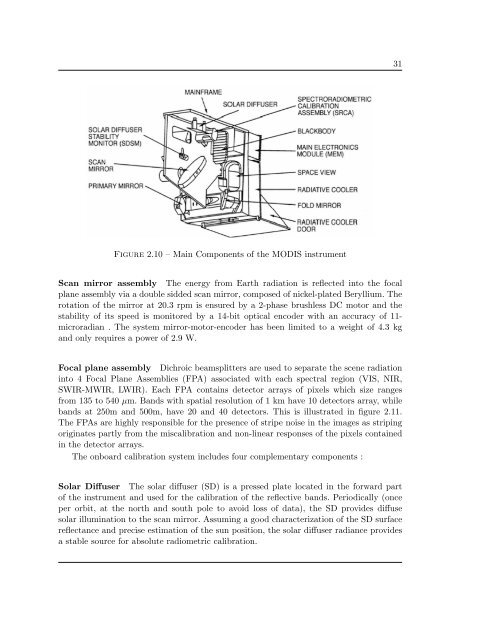Th`ese Marouan BOUALI - Sites personnels de TELECOM ParisTech
Th`ese Marouan BOUALI - Sites personnels de TELECOM ParisTech
Th`ese Marouan BOUALI - Sites personnels de TELECOM ParisTech
You also want an ePaper? Increase the reach of your titles
YUMPU automatically turns print PDFs into web optimized ePapers that Google loves.
31<br />
Figure 2.10 – Main Components of the MODIS instrument<br />
Scan mirror assembly The energy from Earth radiation is reflected into the focal<br />
plane assembly via a double sid<strong>de</strong>d scan mirror, composed of nickel-plated Beryllium. The<br />
rotation of the mirror at 20.3 rpm is ensured by a 2-phase brushless DC motor and the<br />
stability of its speed is monitored by a 14-bit optical enco<strong>de</strong>r with an accuracy of 11-<br />
microradian . The system mirror-motor-enco<strong>de</strong>r has been limited to a weight of 4.3 kg<br />
and only requires a power of 2.9 W.<br />
Focal plane assembly Dichroic beamsplitters are used to separate the scene radiation<br />
into 4 Focal Plane Assemblies (FPA) associated with each spectral region (VIS, NIR,<br />
SWIR-MWIR, LWIR). Each FPA contains <strong>de</strong>tector arrays of pixels which size ranges<br />
from 135 to 540 µm. Bands with spatial resolution of 1 km have 10 <strong>de</strong>tectors array, while<br />
bands at 250m and 500m, have 20 and 40 <strong>de</strong>tectors. This is illustrated in figure 2.11.<br />
The FPAs are highly responsible for the presence of stripe noise in the images as striping<br />
originates partly from the miscalibration and non-linear responses of the pixels contained<br />
in the <strong>de</strong>tector arrays.<br />
The onboard calibration system inclu<strong>de</strong>s four complementary components :<br />
Solar Diffuser The solar diffuser (SD) is a pressed plate located in the forward part<br />
of the instrument and used for the calibration of the reflective bands. Periodically (once<br />
per orbit, at the north and south pole to avoid loss of data), the SD provi<strong>de</strong>s diffuse<br />
solar illumination to the scan mirror. Assuming a good characterization of the SD surface<br />
reflectance and precise estimation of the sun position, the solar diffuser radiance provi<strong>de</strong>s<br />
a stable source for absolute radiometric calibration.















